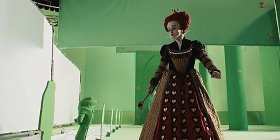|
• Source: 3Dup.com - The Computer Graphics Portal • URL: http://3dup.com/news/view.vfx?nid=361 • Category: Miscellaneous
Release Date: March 5, 2010
3Dup.com - March 18, 2010 - 11:45
 This film was originally set to be released in 2009, but was pushed to March 5, 2010. Principal photography was scheduled for May 2008, but did not begin until September and concluded in three months. Scenes set in the Victorian era were shot at Torpoint and Plymouth from September 1 to October 14. Two hundred and fifty local extras were chosen in early August. Locations included Antony House in Torpoint, Charlestown, Cornwall and the Barbican, however, no footage from the Barbican was used. Motion capture filming began in early October at Sony Pictures Studios in Culver City, California, though the footage was later discarded. Filming also took place at Culver Studios. Burton said that he used a combination of live action and animation, without motion capture. He also noted that this was the first time he had filmed on a green screen. Filming of the green screen portions, comprising 90% of the film, was completed after only 40 days. Many of the cast and crew felt nauseous as a result
of the long hours surrounded by green, with Burton having lavender lenses fitted into his glasses to counteract the effect.
This film was originally set to be released in 2009, but was pushed to March 5, 2010. Principal photography was scheduled for May 2008, but did not begin until September and concluded in three months. Scenes set in the Victorian era were shot at Torpoint and Plymouth from September 1 to October 14. Two hundred and fifty local extras were chosen in early August. Locations included Antony House in Torpoint, Charlestown, Cornwall and the Barbican, however, no footage from the Barbican was used. Motion capture filming began in early October at Sony Pictures Studios in Culver City, California, though the footage was later discarded. Filming also took place at Culver Studios. Burton said that he used a combination of live action and animation, without motion capture. He also noted that this was the first time he had filmed on a green screen. Filming of the green screen portions, comprising 90% of the film, was completed after only 40 days. Many of the cast and crew felt nauseous as a result
of the long hours surrounded by green, with Burton having lavender lenses fitted into his glasses to counteract the effect. More Information at www.disney.go.com/disneypictures/aliceinwonderland. Image and Video Courtesy of Walt Disney Pictures. Video Encoding: 3Dup.com |